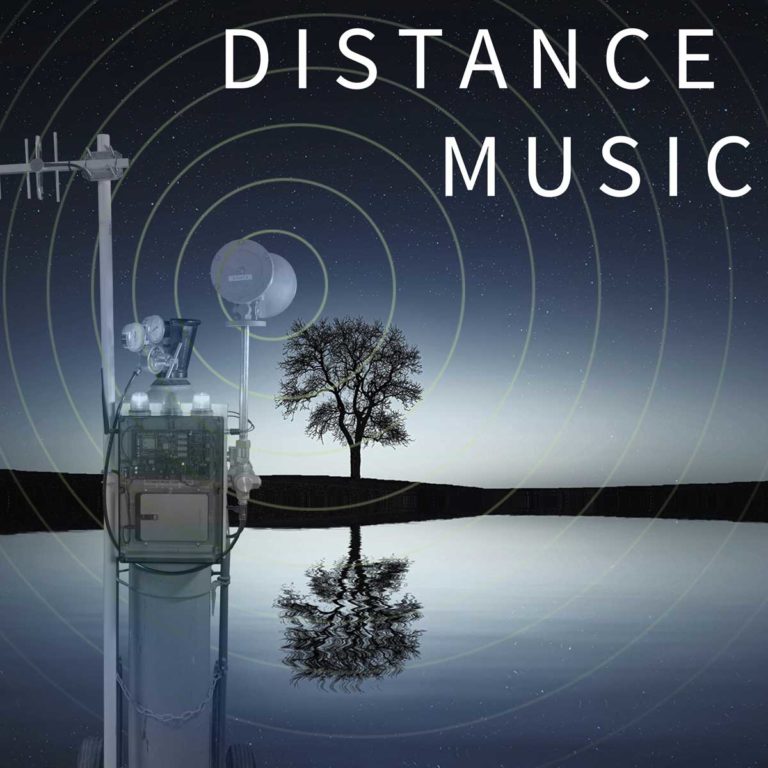
Distance Music is my name for a large-scale outdoor concert environment where the distances between the locations of its musical sources are equivalent to the distance required for sound to travel a specific subdivision of the music’s beat.
I refer to this musical invention as “Distance Minimalism” when the experience is an exploration of the time/space continuum , and, as “Distance Music” when the experience is focused on music and music development. Distance Minimalism pieces employ mostly sounders, but can add live improvising musicians. Distance Music is a full-fledged composition with written scores and parts.
Composing either approach begins with its location, which determines the area available (5 acre minimum), the musician forces available, and what areas where the audience members can walk (walking is a requirement). Once the space and available musicians is defined, a ground placement geometry needs to be decided (see “How to Compose Distance Music“). Sounders and musicians are placed at prominent points on the geometric figure to produce desired rhythmic results. The audiences walk throughout the area listening to the music change as a result the changing distances to musical sources.
Much like an open-world MMORG (massively multiplayer online role-playing game), the music encountered at a Distance Minimalism event results from a combination of the event’s layout and wherever each audience (player) member decides to walk. There is no stage.Distance Music concerts construct a multidimensional environment, but, no single or preferred ‘version’ of the composition exists. The music experienced by anyone is a result of where they choose to be within the concert space, and, since a person can only be in one place at a time, every attendee will hear a different concert. The composer doesn’t know where his audiences will be standing or walking, either, so designs interesting probabilities for as much of the space and time as possible. The music emanates from many directions, encouraging 360˚ listening.
In its entirety, the music has two layers: the shifting ground (cantus infirmus, lol) and musician bubbles. The shifting ground music comes from a set of radio-controlled, loud, acoustic instruments called “sounders,” placed precisely throughout the concert area on points that share a common denominator of distance, which I call the primary interval (PI). The number of sounders are limited and thus deliver a minimal pitch collection which repeat throughout. The musical interest develops with attention to 1) the change of the melodic order and rhythm of the shifting ground and 2) the counterpoint provided by musician bubbles which can be heard when the listener is near enough to their performance over the shifting ground.
THE SHIFTING GROUND
The shifting ground is the primary construction and musical component of Distance Music. Since the speed of sound is constant at air temperature, each note’s arrival time will be proportional to the distance traveled from its sounder. When all sounders receive a command to play their note, listeners hear them all, not as a chord – but in the order from closest to farthest as a melodic “constellation.” As the audience members walk, their constellation morphs because pitches emanating from sounders they’re walking towards move to the front and pitches becoming more distant move backward. Opposite points around the installation will have an exact retrograde relationship. All these constellation variations exist simultaneously to be discovered by the walking audience! By consciously witnessing the continual changes in melody, they are ably to explore the time-space continuum of sound: a physical feature of everyday sound that is ordinarily unnoticed.
Available Sounders:
7 Nathan AirChime Train Horns, choosing from C4, Eb4, E4, F4, Gb4, G4, Ab4, A4, Bb4, B4 and D5. Powered by compressed breathing air regulated to 75psi. Controlled by 12V Parker Poppet Solenoid. Code instructions are activated through ISM band radio built by Pribusin, Inc.
7 Glockenspeil bars G5 through C8. Powered by 12V ram/cylinder push solenoids. Code instructions are activated with an ISM band radio built by Pribusin, Inc.
MUSICIAN BUBBLES
Since sounders are set up separated by distances multiples of a primary interval, listeners in places that share that quality will hear pitches arrive in integer multiples or, in musical terms: a meter. A ‘beat’ can be felt at these metrically stable locations, allowing me to compose an additional layer of counterpoint there. These soloists or small chamber ensembles playing there are called “Musician Bubbles” since they will only be heard when nearby. Not only do musician bubbles create a more profound musical experience, but they also provide personality and human connection. Optionally, I can furnish the ensembles with a remote radio set up as a metronome.
Walking towards a musician bubble, audiences can control the speed of how rhythmic chaos builds into order. Leaving one, audiences can control the speed at which music returns to metric chaos.
